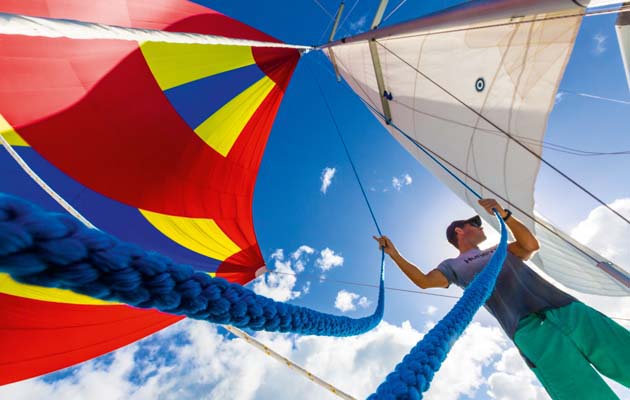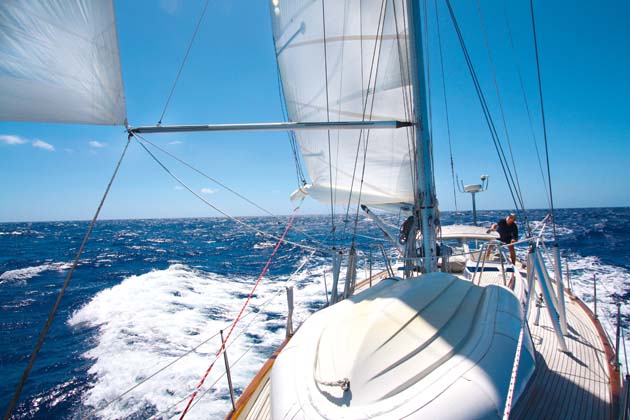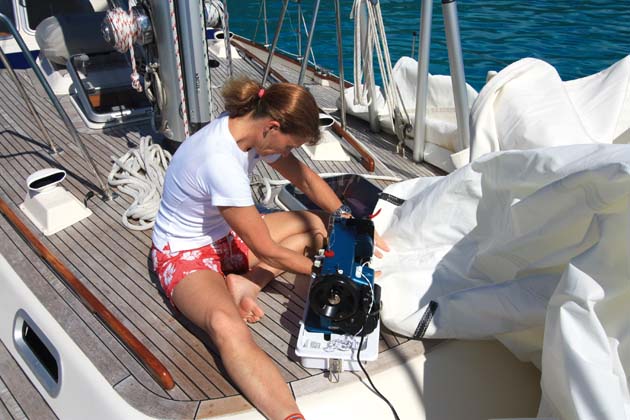We survey a number of skippers in the Atlantic Rally for Cruisiers about their choice of downwind sails, the problems they had and what they might do differently. Elaine Bunting reports
This is one of the biggest questions skippers face when equipping a yacht for bluewater sailing, yet in some ways the most difficult to answer. It’s tricky because there are so many variables: size of the budget; how many crew you have and the watch systems you intend to run; as well as whether or not you will be regatta racing afterwards.
To get an idea of the choices and their relative merits, we turned to the Atlantic Rally for Cruisers (ARC) and asked a small selection of skippers what sails they had taken, which they used and for how long, and if they would change anything in hindsight.
Even on a tradewinds passage, winds can go light and everyone in our survey had some kind of coloured downwind sail to use in softer winds, whether a gennaker, asymmetric or symmetric spinnaker, Parasailor or free-flying reaching sails. Everyone who took these sails used them at some point – though not always as much as they may have envisaged.
Deep downwind
A popular combination was a gennaker, or asymmetric spinnaker poled-out and run goosewinged with the mainsail. With the pole stabilised firmly with foreguy and afterguy, this is a good solution. El Mundo, an Oyster 56, for example, was equipped with a mainsail, yankee, gennaker set from her bowsprit on a top-down furler, and a symmetric spinnaker for deep downwind angles. The skipper noted: “Poled-out gennaker was very stable and low-maintenance for crew goose-winged, but needs careful watching in squalls.”
The skipper of Jo, a Sweden 42, commended the use of a pole for either gennaker or genoa, depending on wind and sea conditions, saying: “We particularly like the twin headsail combination for ease and manoeuvrability downwind.”
In either mode, this set-up allows crews to run fairly deep downwind. It is important to remember that most reasonably heavy-displacement cruising boats – and they will be at their heaviest when fully provisioned – will obtain quickest VMG by sailing deep downwind and not at hot angles. Without a pole, it is difficult to sail sufficiently deep and the chances of a wrap around the forestay increase.
Around half of the skippers in our survey noted that they took down spinnakers or gennakers at night and ran with main and genoa. “Headsail and mainsail only, one reef in main at nights and when windy,” noted one skipper. “Poled-out genoa at night,” said another. The reasons for this are simple: it can be difficult to spot squalls in the dark.
Radar helps identify these, but is not a failsafe against being taken unawares. And if squalls are frequent, skippers often feel that the extra few miles that might be gained overnight under spinnaker are not worth the hassle of getting off-watch crew up to help, and the risks involved in someone going on the foredeck at night.
But it was interesting to see from our survey that there was a split among those cruising. Some preferred a standard operating policy of putting a reef in the mainsail overnight and poling out their genoa, and rehoisting a spinnaker or gennaker during the day; others decided their tactics on the fly, depending on conditions.
The case for more sleep
A more conservative approach definitely makes sense for a double-handed crew, a smaller crew running single watches and those skippers who put a premium on sleep.
On this point, it is worth pointing out that if there happens to be equipment failure to grapple with (often the case) as well as multiple sail changes, skippers can end up being quite sleep-deprived. So it really is worth calculating where you want to set the ‘relaxed experienced versus fastest crossing time’ slider.
But, just as notably, crews who adopted a conservative approach at the beginning often gradually grew in confidence and began flying spinnakers at night. This was particularly true of those who had a Parasailor. These sails, with their characteristic envelope-shaped hole in the shoulder, are claimed to be able to handle increases in wind more safely by venting the excess and are sometimes used on longer passages with no white sails at all. They have a good representation on the ARC and over half our survey skippers had bought and used one.
“Parasailor was excellent, used eight days and was great downwind,” commented the skipper of Miss Liz II, a Hanse 505. “We gradually moved to main with one reef and Parasailor day and night as we got more confident,” he added.
“Used poled-out genoa at night and Parasailor day,” said the skipper of Morning Haze, a Hunter 410.
Parasailors
Others kept the sail for lighter winds. “At night had two reefs plus two genoas with two poles so we could simply furl in and the day same, but Parasailor in under 15 knots,” said the skipper of Kymothoe, a Hanse 470e.
“Used Parasailor 290 hours, main and genoa for 131 hours and main and gennaker 35 hours,” said the skipper of Ooroo 1, a Lagoon 450 catamaran.
A point that two skippers who had Parasailors noted is that they would have preferred smaller sails. A claim about the Parasailor is that it can handle higher winds than conventional spinnakers and it is possible that skippers were tempted to opt for larger sails. Caution may be needed here.
But overall, reviews were good. There is excellent sales service in Las Palmas and an opportunity for crews to try out their Parasailors and get some expert instruction in how to set, use and retrieve them, which I suspect is a large ingredient in their success in the ARC.
Chafe is a culprit of many difficulties with coloured downwind sails. “Halyard of asymmetric chafed in two days,” said one skipper. Halyard chafe – and indeed sheet and guy chafe – can be a major problem on a long passage with such a large amount of rolling movement and is dealt with in more detail in the panel (right).
Another cause is gear failure. One skipper had a gennaker that saw only four hours’ use before it blew out. “Split in accidental gybe caused by autopilot failure,” he said.
Indeed, gear failure is the single biggest cause of sail damage, according to Andrew Bishop, managing director of the ARC. He is in Saint Lucia each year and sees the whole fleet arriving, and has this observation: “I think quite a lot of downwind sail damage is down to associated equipment failure, not necessarily the sail itself. We hear of track fittings going, spinnaker boom fittings, blocks used for sheets or guys and if you get a failure on those critical points it quite often leads to damage on the sail because crews can’t get it down in a hurry.”
So it is important to consider the spec of all fittings and blocks for the higher loads and snap reloads that sails and sheets are going to see on an ocean passage.
Sail damage
Sail damage is much more common on crossings, and he cautions: “I think in a windy year [damage happens] when people are caught unawares. You get comfortable with a sail configuration, especially in cruising mode, when you get it nice and set, even if it’s just wing and wing, and perhaps get lulled into a false sense of security. Then you only need a wave or a gust to catch you out and something goes.”
It would seem sensible, if you are flying a spinnaker, to be fully aware of the maximum true windspeed it is designed handle and respect that, and not leave getting it down too long. Your sailmaker can advise you of the parameters of the sail. Worth noting also is that two of our skippers, when commenting on what they would do differently next time, said that they’d have a sock to dowse a gennaker. “Use a sock instead of top-down furler for gennaker,” one wrote. Snuffers and socks generally work well, provided you’ve got the lines sorted out and in the right order.
Twin headsails, poled-out on each side, was used on one boat in our survey, but seems to have fallen out of favour as a downwind set-up. But an interesting question to ask is whether you really need a spinnaker at all. Sailing wing and wing with a poled-out headsail can work fine (see our Bluewater Sailing Techniques videos on www.yachtingworld.com) And, one argument goes, if it goes really light, you can get quite a lot of diesel-powered miles in the right direction for the cost of a new sail.
The simple answer is that an Atlantic crossing with plain sails is not only perfectly possible, but how most of the cruising class sail for a majority of the time. Whether or not you really need to invest in one depends on the kind of sailing you will be doing afterwards.
Bishop comments: “For me the biggest thing is people should be using [a spinnaker] and practising before they set off before they go across the Atlantic. Lots of people are using on the ARC something they haven’t used much before as a crew and inexperience often means they don’t get full benefit from it.”
And while a proper downwind sail for deep downwind angles is a useful part of the sailing armoury and an essential if continuing onwards across the Pacific, how invaluable is it for the ARC alone?
“You don’t necessary need lots of equipment if you are just doing the ARC and then a couple of weeks in the Caribbean and going back,” explains Bishop. “Yes, there are things that are nice to have. For example, do you really need to go out and buy a special downwind sail if you are just doing the ARC? If you haven’t used it before Las Palmas and you’ve got to that point without it, is it really going to make that much difference for the 18 days that you are crossing?”








